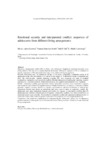Mostrar o rexistro simple do ítem
Emotional security and interparental conflict: responses of adolescents from different living arrangements
| dc.contributor.advisor | ||
| dc.contributor.author | López-Larrosa, Silvia | |
| dc.contributor.author | Sánchez-Souto, Vanesa | |
| dc.contributor.author | Ha, Anh P. | |
| dc.contributor.author | Cummings, E. Mark | |
| dc.date.accessioned | 2019-05-20T10:18:43Z | |
| dc.date.issued | 2019-03-02 | |
| dc.identifier.citation | López-Larrosa, S., Sánchez-Souto, V., Ha, A. P., & Cummings, E. M. (2019). Emotional Security and Interparental Conflict: Responses of Adolescents from Different Living Arrangements. Journal of Child and Family Studies, 28(5), 1169-1181. | es_ES |
| dc.identifier.issn | 1062-1024 | |
| dc.identifier.uri | http://hdl.handle.net/2183/22921 | |
| dc.description.abstract | [Abstract] Objectives. Interparental conflict (IPC) is linked with adolescents’ heightened emotional insecurity about family relations. Our aim was to examine Spanish adolescents’ differential responses to IPC as a function of specific dimensions of IPC and emotional security, in two different living arrangements. Methods. Participants were 162 adolescents (M age = 15.55 years), comprising a community sample of 86 adolescents living with their families (CF) and an at-risk sample of 76 adolescents living in residential care (RC). Six video-recorded vignettes depicting everyday IPC were presented, two each of escalated (destructive), constructive, and unresolved conflicts. Multiple dimensions of adolescents’ emotional security responses (i.e., emotional reactivity, behavioral regulation, and cognitive representations) were examined. Results. Constructive conflicts generated more intense and positive emotions, more constructive cognitive representations, and a behavioral regulation pattern of higher interference. As expected, destructive conflicts generated negative emotions, destructive cognitive representations, and less interference in both groups. Unresolved conflicts had effects on adolescents that were closer to those of destructive conflict. RC adolescents were more emotionally insecure and reactive in response to constructive conflicts than CF adolescents and exhibited a blunted pattern of response to destructive conflicts, even when overall levels of emotional security were controlled. Sensitization to constructive conflict also appeared in adolescents low in emotional security. Girls evidenced greater involvement, less positivity and more negativity than boys. Conclusions. Our results have implications for understanding RC adolescents’ greater risk for adjustment problems and for broadening the scope of Emotional Security Theory in future research to include additional living arrangements. | es_ES |
| dc.language.iso | eng | es_ES |
| dc.publisher | Springer | es_ES |
| dc.relation.uri | https://doi.org/10.1007/s10826-019-01364-1 | es_ES |
| dc.rights | The final publication is avaliable at Springer Link | es_ES |
| dc.subject | Interparental conflict | es_ES |
| dc.subject | Adolescent | es_ES |
| dc.subject | Residential care | es_ES |
| dc.subject | Emotional security | es_ES |
| dc.title | Emotional security and interparental conflict: responses of adolescents from different living arrangements | es_ES |
| dc.type | info:eu-repo/semantics/article | es_ES |
| dc.rights.access | info:eu-repo/semantics/embargoedAccess | es_ES |
| dc.date.embargoEndDate | 2020-03-02 | es_ES |
| dc.date.embargoLift | 2020-03-02 | |
| UDC.journalTitle | Journal of Child and Family Studies | es_ES |
| UDC.volume | 28 | es_ES |
| UDC.issue | 5 | es_ES |
| UDC.startPage | 1169 | es_ES |
| UDC.endPage | 1181 | es_ES |
Ficheiros no ítem
Este ítem aparece na(s) seguinte(s) colección(s)
-
GI-IPRF - Artigos [133]






